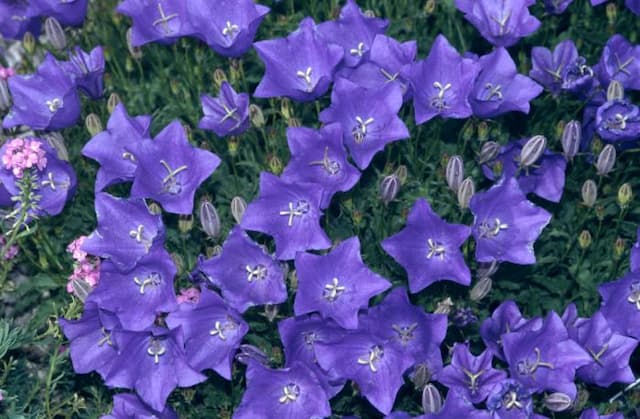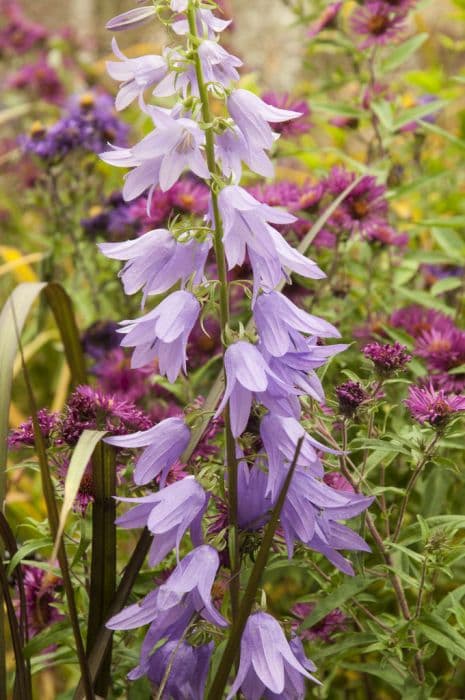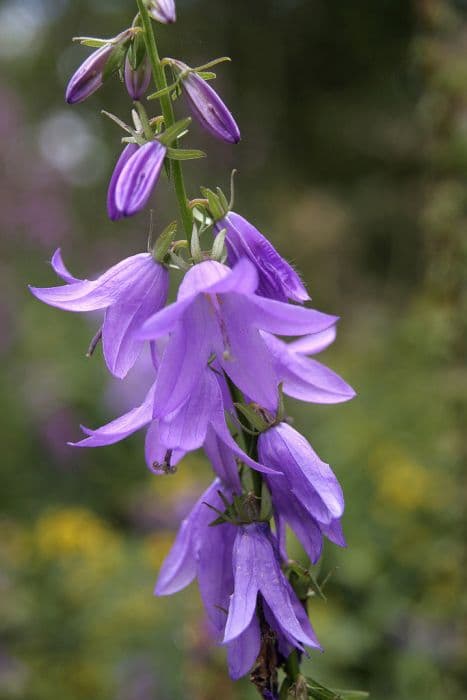Edging Lobelia Lobelia erinus 'Crystal Palace'

ABOUT
Lobelia erinus 'Crystal Palace' features masses of stunning deep blue flowers which are small and delicate with a tubular shape. Each blossom is edged in white, adding a striking contrast to the intense blue petals. The deep green foliage beneath these flowers is dense and consists of small, narrow leaves that create a lush backdrop for the prolific blooms. This variety is known for its rich coloration and tidy, compact growth habit that creates a mounded appearance. As a popular choice for gardeners, 'Crystal Palace' adds vibrant color and a lush, full look without discussing its specific dimensions. It is often used for edging garden beds or as an addition to containers, where it cascades softly over the edges.
About this plant
 Names
NamesFamily
Campanulaceae.
Synonyms
Edging Lobelia, Garden Lobelia, Trailing Lobelia, Bedding Lobelia.
Common names
Lobelia erinus 'Crystal Palace'.
 Toxicity
ToxicityTo humans
Lobelia erinus, commonly known as the edging lobelia or garden lobelia, contains several alkaloids such as lobeline, lobelanine, and lobelanidine, which can be toxic if ingested in significant quantities. It is not typically considered a highly toxic plant to humans, but ingestion can lead to symptoms such as nausea, vomiting, diarrhea, cough, dizziness, tremors, and increased saliva. Severe poisoning, which is rare, might cause convulsions, hypothermia, rapid heartbeat, hypotension, coma, and potentially even death. Most cases of poisoning in humans are mild and self-limiting, but ingestion of any part of the plant should be avoided, and medical attention should be sought if symptoms are severe or concerning.
To pets
Edging lobelia or garden lobelia's toxicity to pets, such as cats and dogs, is similar to its toxicity to humans. It contains alkaloids that can cause harm if ingested in large amounts. Symptoms of poisoning in pets can include vomiting, diarrhea, excessive salivation, abdominal pain, and depression. Severe cases might lead to more serious symptoms such as tremors, respiratory difficulties, and convulsions. If you suspect your pet has ingested edging lobelia, it is important to consult your veterinarian, especially if any adverse symptoms are observed. It's generally advisable to prevent pets from consuming any part of the plant.
 Characteristics
CharacteristicsLife cycle
Annuals
Foliage type
Evergreen
Color of leaves
Green
Flower color
Blue
Height
0.5 feet (15 cm)
Spread
0.5 feet (15 cm)
Plant type
Herb
Hardiness zones
10
Native area
South Africa
Benefits
 General Benefits
General Benefits- Attracts pollinators: It is known to attract bees and butterflies, which is beneficial for the pollination of surrounding plants.
- Easy to grow: Requires minimal maintenance and is relatively easy to care for, which is ideal for beginner gardeners.
- Drought-tolerant: Once established, the plant has a moderate tolerance to drought conditions, reducing the need for frequent watering.
- Compact size: With its small stature, it is well-suited for container gardening or as an edging plant in garden beds.
- Colorful blooms: Produces vibrant blue flowers with an eye-catching contrast against its dark foliage, adding aesthetic appeal to any garden space.
- Long flowering period: Blooms continuously from spring to fall, providing long-lasting color to the garden landscape.
- Versatile usage: Can be used in hanging baskets, window boxes, and as ground cover, offering various landscaping options.
- Deer resistant: Less attractive to deer, which helps prevent damage to the plant and surrounding vegetation.
 Medical Properties
Medical PropertiesThis plant is not used for medical purposes.
 Air-purifying Qualities
Air-purifying QualitiesThis plant is not specifically known for air purifying qualities.
 Other Uses
Other Uses- Lobelias such as 'Crystal Palace' can be used as a natural pest repellent in the garden, as some pests find their taste and smell unpleasant.
- They can function as a living mulch to retain soil moisture and control weeds when planted densely in garden beds.
- 'Crystal Palace' can be used in educational settings, such as schools or workshops, to teach about plant growth, flowering, and pollination.
- This plant may be used in art, as the vibrant blue flowers can be pressed and included in botanical prints or mixed-media art projects.
- Gardeners might plant 'Crystal Palace' as a companion plant to vegetables like broccoli or cabbage to help attract beneficial insects.
- They can be used in pet-friendly gardens as Lobelia is generally considered non-toxic to cats and dogs.
- 'Crystal Palace' can serve as a natural dye source, where the flowers might be used to create shades of blue or green on fabric.
- The contrasting blue flowers and dark foliage can be incorporated into moon gardens, designed to be enjoyed in the evening or night.
- Photographers might utilize 'Crystal Palace' as a vibrant foreground or background subject in garden photography.
- They are ideal for miniature gardens or fairy gardens due to their compact size and colorful blooms, adding a touch of fantasy aesthetics.
Interesting Facts
 Feng Shui
Feng ShuiThe Lobelia is not used in Feng Shui practice.
 Zodiac Sign Compitability
Zodiac Sign CompitabilityThe Lobelia is not used in astrology practice.
 Plant Symbolism
Plant Symbolism- Devotion: Lobelia, often associated with an intense blue color, symbolizes devotion and loyalty, embodying deep and trustworthy feelings.
- Enchantment: The delicate beauty of the 'Crystal Palace' variety has an enchanting presence, often symbolizing the captivating allure of the natural world.
- Good Fortune: With its abundant flowering and graceful habit, lobelia is sometimes considered a symbol of good luck and prosperity in the garden.
- Healing: Historically, lobelia has been used medicinally, hence it can also symbolize the healing power of nature and the importance of well-being.
 Water
WaterThe Edging Lobelia should be watered regularly, ensuring the soil remains moist but not soggy. Aim to water deeply once a week, providing about one gallon of water to saturate the root zone. During hot or windy weather, the Edging Lobelia may require more frequent watering, perhaps every 2-3 days. Adjust your watering schedule according to the rainfall and temperature, as overwatering can lead to root rot, while under-watering can stress the plant. It's important to water the plant at the soil level to avoid wetting the foliage, which can lead to disease.
 Light
LightThe Edging Lobelia thrives in a location that receives full sun to partial shade. It performs best when it gets at least 4-6 hours of sunlight each day. The ideal spot would be one where it receives morning sunlight and some afternoon shade, especially in areas with very hot summers, as this can help prevent the delicate foliage from scorching.
 Temperature
TemperatureEdging Lobelia prefers a temperature range of 60°F to 70°F for optimal growth. It can tolerate a minimum temperature of about 40°F but is sensitive to frost and will not survive temperatures below freezing. The ideal climate for this plant would be one that is cool to moderate, avoiding extremes of heat and cold.
 Pruning
PruningPruning Edging Lobelia is necessary to maintain its shape and encourage bushier growth with more flowers. Trim the plant lightly after the first flush of blooms has faded, which is typically midsummer. Deadheading spent flowers frequently throughout the growing season can also stimulate new blooms. The best time to prune Edging Lobelia significantly is in the early spring, just before new growth begins.
 Cleaning
CleaningAs needed
 Soil
SoilLobelia, commonly known as Edging Lobelia, thrives best in a well-draining soil mix with a slightly acidic to neutral pH of 6.0-7.0. A soil mixture consisting of peat, loam, and sand in equal parts, or a commercial potting mix with added perlite for improved drainage, is ideal for this plant.
 Repotting
RepottingEdging Lobelia typically does not require frequent repotting and may only need it every couple of years. However, if the plant outgrows its container or the soil appears exhausted, it is best to repot in spring.
 Humidity & Misting
Humidity & MistingEdging Lobelia prefers moderate to high humidity levels but is adaptable to typical household humidity. Aim to maintain a humidity level around 40-50% for optimal growth.
 Suitable locations
Suitable locationsIndoor
Keep Edging Lobelia in bright, indirect light and water moderately.
Outdoor
Plant in partial shade and keep soil moist for best Edging Lobelia growth.
Hardiness zone
10-11 USDA
 Life cycle
Life cycleLobelia 'Crystal Palace' begins its life as a seed, typically sown in early spring under protection, as it is sensitive to cold temperatures. Once germinated, seedlings will develop true leaves and, when conditions are suitable, can be transplanted outdoors after the risk of frost has passed. The plant enters its vegetative stage, growing compact foliage and branching stems, and in the right conditions, it will start to produce vibrant blue flowers by mid to late summer. The flowering stage continues throughout the summer and into early autumn, attracting pollinators to the garden. After pollination, the plant sets seed. As temperatures drop in late autumn, Lobelia 'Crystal Palace' will complete its annual cycle, dying back after seeding, but may self-seed in suitable climates.
 Propogation
PropogationPropogation time
Spring-Summer
Propogation: Lobelia, specifically Lobelia erinus 'Crystal Palace', is typically propagated by seed. The best time to sow Lobelia seeds is in late winter to early spring if you are starting them indoors, or after the danger of frost has passed if you are directly sowing them outside. When propagating Lobelia by seed, it's important to start with a fine seed starting mix, sprinkle the tiny seeds on the surface, and gently press them into the soil as Lobelia needs light to germinate. Keep the soil moist but not waterlogged and maintain a temperature of about 70-75 degrees Fahrenheit (21-24 degrees Celsius) for optimal germination, which usually takes about 14-21 days. After the seedlings have sprouted and grown large enough to handle, they should be thinned or transplanted to allow for proper growth.









